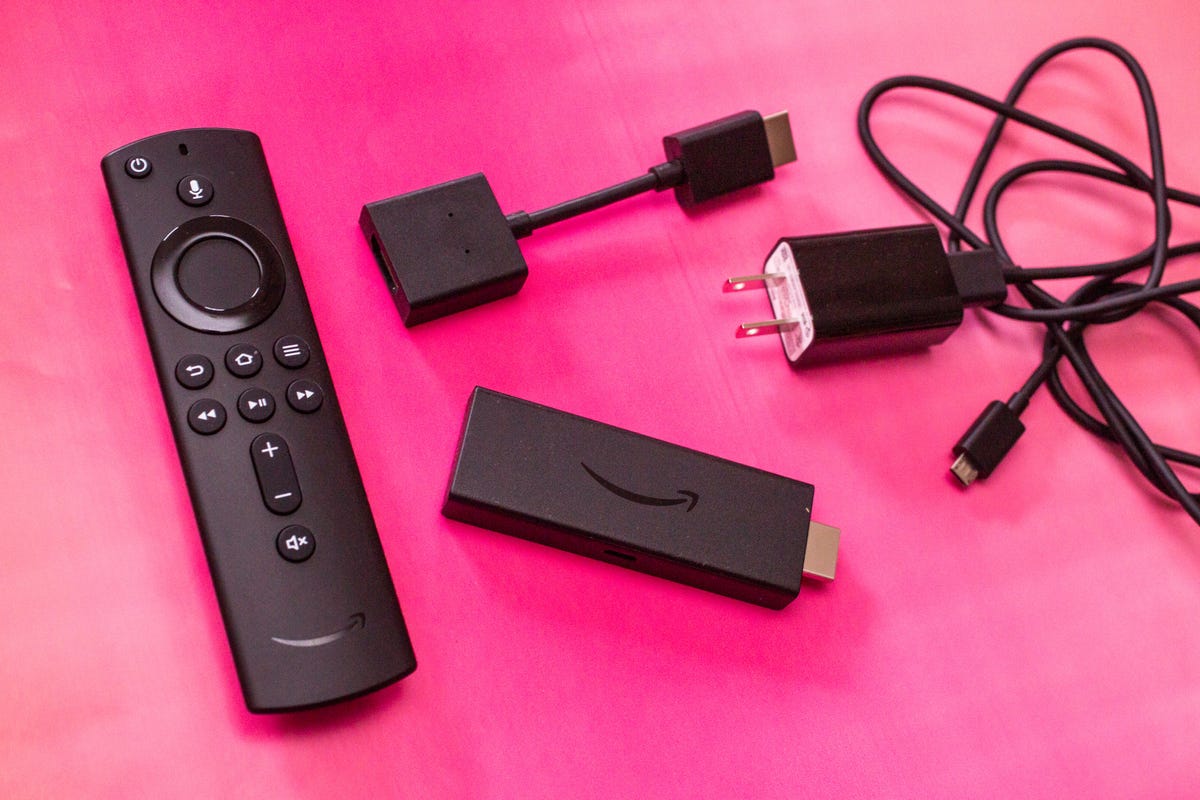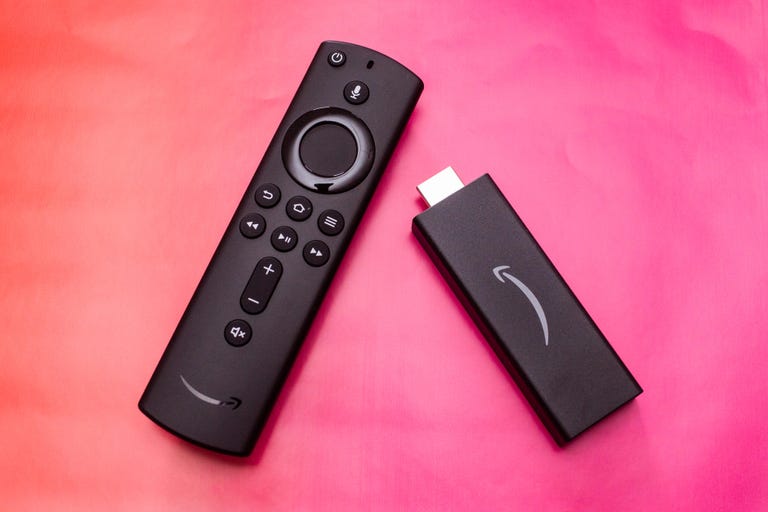 Why You Can Trust CNET
Why You Can Trust CNET Amazon Fire TV Stick review: TV control is nice, but Roku (and Lite) are better sticks
Amazon's $40 streamer is a fine device, but we recommend spending less for Fire TV Lite or getting the Roku Express 4K Plus instead.
Streaming TV continues to grow in popularity, with new services and options every day, and to keep up most of the major device makers released new products in the past year you can hook to any TV. Roku has the new Streambar and the Roku Express 4K Plus, Google has the Chromecast with Google TV and Amazon has its cheapest streamer yet: the $30 Fire Stick TV Lite. Amazon also sells the $40 Fire TV Stick, the subject of this review.
Like
- Inexpensive
- Remote offers Alexa voice and TV control
- Wide range of streaming apps
- Integrates well with Echo speakers
Don't like
- The cheaper Lite is a better value
- The step-up 4K stick is better for 4K TVs
- More complex menus than Roku
Like some of its competitors the $40 Fire Stick's remote has buttons for volume, mute and power, allowing you to control those functions on your TV -- and maybe ditch your TV remote. Those remote buttons are the only real difference between the $30 Stick Lite and the $40 Stick, so you're basically paying $10 for TV control.
The $40 Stick (2020) is the HD-only middle child between the cheaper Lite and the more capable Fire TV Stick 4K , and both of those are better choices overall. Yes, that TV control is nice, and the Fire Stick does offers a lot for your $40, including integration with existing Echo devices; a fine selection of apps (it now has both HBO Max and Peacock); and a slick interface. But Fire TV still pushes its Prime Video store in search results, and the home screen can be a little too busy for people who know what they want to watch. At the same price the Roku Express 4K Plus offers better features and value, and for $10 less the Lite is an unbeatable deal.
What is it?

Fire TV Sticks are USB stick-sized devices that plug into a spare HDMI port on your TV. They stream audio and video content from dozens of different apps over your Wi-Fi connection. While anyone can use one of these devices, being an Amazon Prime subscriber allows you to watch added programming.
The remote itself hasn't physically changed much since the first Fire TV was introduced, and it lacks the premium feel of the Roku remote or Google's new remote. The new Fire Stick remote does add the ability to control your TV volume, though it lacks the shortcuts to Netflix or other often-used services. Setting the remote up with a TV takes about 30 seconds and it can even control a receiver (I used it with a Sony TV and an Onkyo receiver without issue).
Alongside the Fire TV Lite, these are the first devices we've seen to offer HDR but not 4K resolution, and it raises the question of what kind of TV it's designed for. There are hundreds of 4K HDR TVs out there but I tried doing a search for 1080p TVs that can do HDR on Best Buy's site and found only four. For most people with 4K HDR TVs, we'd recommend getting a streamer that can actually do 4K instead of a 1080p streamer like the Stick.
The stick comes with a power adapter and Amazon strongly recommends you use this. While you could use the USB ports on your TV to power the device, it means the unit could behave unusually. For example, Dolby Atmos content wouldn't work at all when the unit was plugged into a TV USB port, despite the device declaring it was outputting "Dolby Atmos" -- the sound came out as 5.1.
Lots of streaming apps
The Fire TV sports (get it?) dozens of streaming apps.
Like other streaming devices the number of services that Amazon Fire TV supports is improving all the time. It can access almost all of the major streaming apps, including Amazon Prime Video, Netflix, Hulu, Sling TV, Crackle, Pluto TV, Tubi TV, Amazon Music, Pandora, Spotify and many, many more. The Fire TV platform now offers both HBO Max and Peacock bringing it in line with Roku and Chromecast with Google TV.
What it's like to use
With only a couple of tiny features to separate them -- and the sticks even have the same S3L46N model number -- the Fire TV and Fire TV Lite behaved almost identically in my tests. Both offer a healthy complement of features, tightly integrated voice commands and relative speedy response times.
Using the Fire TV Stick remote is easy, and Alexa searches with the microphone button were more responsive and relevant than using the Echo as a go-between. In contrast, Roku may not have the same robust voice capabilities, but text searches via the Roku remote are generally more targeted toward free or included programs rather than simply "buy now" links.
When it comes to user interfaces there are two different schools of thought: App-centric menus like the Roku and Apple TV ones just show you a grid of apps, so you can't actually browse for something to watch without clicking through to each app. Amazon Fire TV and Google TV take a more content-focused approach, surfacing lots of titles on the home page itself.
If you like to graze for content, the Fire TV might be more appealing, If you know what you want already, or at least what app you want to watch, a Roku is probably a better choice, in part because Amazon's search results skews heavily toward its own (often user-pays-extra) content.
Picture and sound quality were very similar between the Lite and the Fire Stick, and image quality was as good as I'd expect. On paper there's a difference in Atmos audio support: The Stick offers Dolby Atmos audio decoding while the Lite has Dolby Atmos pass-through. The practical difference between them is negligible, however, because an Atmos-capable receiver or soundbar is needed in both cases to hear Atmos audio. Whether the stick or the receiver does the decoding doesn't really matter.
Also, in my testing I've found many services -- including Prime Video and Disney Plus -- require a 4K TV for Atmos to work anyway. In short, I don't consider this feature difference a big deal because most people with decent Atmos setups should (once again) be using a bona fide 4K streamer.
Should you buy it?
If you're in the market for a new $30 or $40 streamer it comes down to a choice between Fire TV's content-first approach versus Roku app-first one. If you're familiar with Roku's simple menu design the number of tiles and options on the Fire TV Stick's home page can be overwhelming.
If you already have a Fire Stick, there's absolutely no reason for you to buy the 2020 version. Dolby Atmos and HDR are weird add-ons for 1080p devices, and if Amazon wanted to offer something unique at the price it should have included full 4K support. As it is, if you have a decent 4K TV then you should get a real 4K streamer like the Roku Express 4K Plus. And if you want to save money, go with the Fire TV Lite.
First published Oct. 8 2020, updated June 2021 with addition of Peacock.


